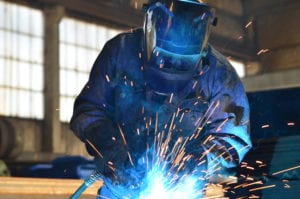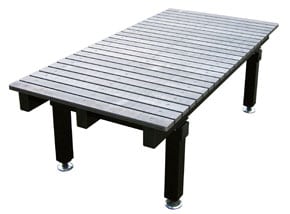Welding tables are vital tools in any welding environment, however big or small it may be. A good, high-tech design can minimize down time and play a vital role in achieving consistently good work.
But how do you decide which tables are best for the different metals to be welded?
While the most common welding tabletops are made from carbon steel, welding tables with tops made from an alloy of aluminum and copper are also available and these are much better suited to aluminum welding.
About Steel, Aluminum, and Copper Welding
 Many welders work with various types of steel including carbon steels, low-alloy steels, and stainless steels. Within these groupings, there are many different and more specific types of steel, the most common of which is mild steel, a type of carbon steel. While mild steel contains between 0,15 and 0,35 percent carbon, stainless steel contains considerably more chromium (at least 10 percent) than any other types of steel, and it doesn’t rust or corrode.
Many welders work with various types of steel including carbon steels, low-alloy steels, and stainless steels. Within these groupings, there are many different and more specific types of steel, the most common of which is mild steel, a type of carbon steel. While mild steel contains between 0,15 and 0,35 percent carbon, stainless steel contains considerably more chromium (at least 10 percent) than any other types of steel, and it doesn’t rust or corrode.
Aluminum (Al) is a non-ferrous metal that doesn’t contain iron. It has a low melting point combined with high thermal conductivity that can result in weld defects and discontinuities including porosity and both hot cracking and stress cracking. While used to make a wide range of items for a huge number of different industries, aluminum is also added to steel in tiny percentages to deoxidize it and refine the grain.
Copper (Cu) is sometimes added to steel to make it more resistant to corrosion and to make the steel more malleable and ductile. When used as an element in mild steel it makes the steel a little harder.
Generally, aluminum is not used in its pure form, and a number of alloying elements are commonly added. Typically, aluminum-copper (Al-Cu) alloys contain between two and ten percent copper, sometimes with the addition of other elements. The copper increases the strength of the aluminum and facilitates precipitation hardening.
While carbon steel is used for the top of tables commonly used for welding carbon and other types of steel, an Al-Cu alloy is a much better option for welding stainless steel and aluminum.
Benefits of Al-Cu Welding Tables
Suitable Al-Cu alloys have a much higher tensile strength than carbon steel. Additionally, the low surface hardness doesn’t cause pitting or ferritic scratches that are common when carbon steel is used.
Another huge benefit of using an aluminum-copper alloy top for welding tables is they have a very high thermal conductivity that minimizes adhesion of spatter. The welding process is consequently quicker and cleaner.

But it isn’t just the material that counts; a well-designed welding table is also essential when welding aluminum.
Aluminum-Copper Welding Tables From Forster America
Forster America specializes in cutting edge welding tables, including 3D modular tables that enable welders to complete projects in the quickest, most efficient way possible. Made with slats that can be moved to accommodate jigs and other invaluable accessories, these tables have unlimited options that be used to create a myriad of custom welding solutions. Better still they can accommodate Forster America’s innovative frame welding and railing welding fixtures too.
Ultimately, aluminum is a relatively expensive material and it is paramount that work is done correctly. Forster’s welding tables with Al-Cu tops incorporate the T-slot system that allows for 3D clamping, making it easier for welders to get their work right first time around.
So if you work with aluminum, there is no doubt that Forster America’s Al-Cu welding tables will help to improve quality and productivity. Call us today for more information and pricing.

